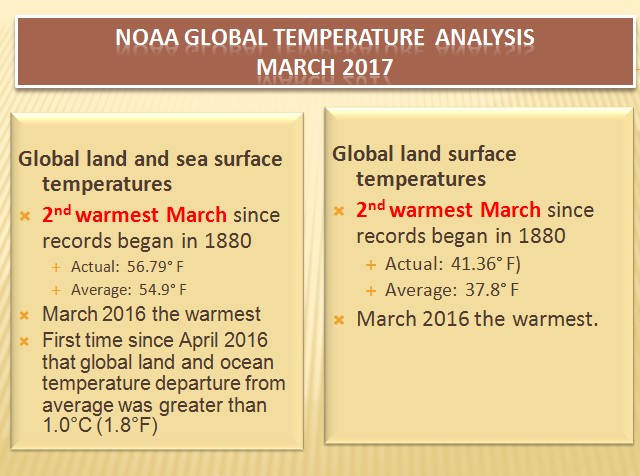Source: NOAA
3/18/2018 update, "5 of the 10 warmest Decembers have occurred since 2013", starts here.
Source: Global Climate Report - December 2017
1/22/2017 update, "Welcome to the U.S. government shutdown The NOAA edition", starts here.
“This is the new normal,” said Gavin A. Schmidt, director of the Goddard Institute for Space Studies, the NASA group that conducted the analysis. But, he said, “It’s also changing. It’s not that we’ve gotten to a new plateau — this isn’t where we’ll stay. In ten years we’re going to say ‘oh look, another record decade of warming temperatures.’”
1/7/2018 update starts here.
Global Climate Report, November 2017. (NOAA)
The global land and ocean temperature during November has increased at an average rate of +0.07°C (+0.13°F) per decade since 1880; however, the average rate of increase is twice as great since 1980.
1/4/2018 update starts here.
Source: NOAA
11/20/2017 update, "The 10 warmest Septembers have occurred in the 21st century", starts here.
Source: NOAA
Deepest red = record warmer10/19/2017 update, "Near-record global warming continues into Augsut 2017", starts here.
Source: NOAA Global Analysis August 2017
The Great Lakes and Mississippi Valley regions of the U.S. were among the few cooler places in August.
Global Analysis: July 2017. (National Oceanic and Atmospheric Association)
Global Analysis: June 2017. (National Oceanic and Atmospheric Association)
The first six months of 2017 have each ranked among the top three warmest months on record, giving way to the second highest January–June period in the 138-year record at 0.91°C (1.64°F) above the 20th century average of 13.5°C (56.3°F), behind the record year of 2016 by 0.16°C (0.29°F), but ahead of 2015 by 0.05°C (0.09°F). (emphasis added)
Source: NOAA
Global Analysis May 2017
Two of the world's hottest spots:
Spain's May 2017 national temperature of 19.0°C (66.2°F) was 2.4°C (4.3°F) above the 1981–2010 average and the second highest May temperature since 1965, behind the record year of 2015.
The May 2017 average temperature across the United Kingdom was 12.1°C (53.8°F) or 1.7°C (3.1°F) above the 1981–2010 average. This was the second highest May temperature since national temperature records began in 1910, behind 2008. Regionally, England, Wales, Scotland, and Northern Ireland had a top third warm May on record.Related reading:
May Continues Earth's Second-Warmest Start in 138 Years; Only 2016 Was Hotter. (Weather.coj, 6/15/2017)
Source: NOAA
Much of the world's oceans also had warmer- to much-warmer-than-average conditions during April 2017, with several locations across the western, central, and southeastern Pacific Ocean, Indian Ocean, and Atlantic Ocean experiencing record warm temperatures. No ocean areas had record cold April temperatures.
Source: NOAA
Global Analysis - March 2017. (National Oceanic and Atmospheric Administration)
March 2017 was characterized by warmer- to much-warmer-than-average conditions across much of Earth's surface. The most notable warm temperature departures from the 1981–2010 average were recorded across the contiguous U.S., Europe, Russia, Mongolia, and Australia, where temperature departures were +3.0°C (+5.4°F) or greater. 4/12/2017 update starts here.

Global Analysis - February 2017. (National Oceanic and Atmospheric Administration)
Warmer- to much-warmer-than-average conditions were present across much of the world's land surfaces, with the most notable warm temperature departures from average (3°C–5°C above the 1981–2010 average) across much of the contiguous U.S., southeastern Canada, and across much of central and eastern Russia.
2/25/2017 post starts here.
Global Analysis - January 2017. (National Oceanic and Atmospheric Administration)
For the oceans, the globally-averaged temperature departure of +0.65°C (+1.17°F) from the 20th century average was the second highest on record for January, behind 2016.
Related post:
When it comes to 'unusual warmth', Morning Consult prefers to keep the blinders on. (1/11/2017)

















No comments:
Post a Comment